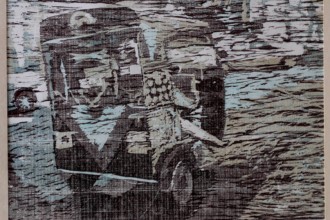Three days passed in bureaucratic silence, until I finally had to pull some strings. The former Danish consul for 40 years, Hans Winther Nielsen, helped me.
Less than one hour passed from the time of my telephone call to monsieur Nielsen until a meeting could be arranged. The organization’s countrywide director called me, apologetically trying to explain. I nodded but kept my thoughts to myself.
I took a scooter taxi to UNHCR’s building. The regional chief Mr. Kourouma, a slightly distracted man, offered to send me a car the following morning. He showed me a map of the area; small stickers marked the villages and camps. On each sticker was a number. In total, more than 100,000 people live in Cameroon with the status “refugee.â€
Many live where no one can reach them, far out in the bush. It complicates our work, he explains.
Sweating and distant, it seemed as if he longed to lie down—as if he were sick. Earlier in the week, armed militia members took him captive. The kidnappers turned out to be former rebels from CAR, hiding among the civilian refugees in Cameroon. After several days of negotiations for better conditions in the camps were Mr. Kourouma and another abducted released.
*
The next morning we drove to Garoua-Boulaï, up to the border and then back.
Near a collection of huts we turned suddenly off the road.
The huts were round and made of straw. The road was impassable, and we parked beside a well that served as a kind of hub for the small community. Hamdiata pointed at the well, just as he’d earlier pointed at a school in Garoua-Boulaï, and just as he would later point at a cement foundation, and he said: “Sanitation.†We walked down a path leading into the bush. The houses were scattered over a large area. The narrow paths connected the huts with each other and with the well. A short distance away were two huts with a field in front. A woman harvested crops with a machete. Hamdiata greeted her, and she returned his greeting; they exchanged a few polite words. The woman’s face was deformed, her eyes set too deeply in her head, and the proportions were wrong, as if her head were too small for her body. She looked at me and swung her machete, while Hamdiata continued walking toward the huts. Then she smiled and nodded.
At the hut an old woman approached us. Both women were dressed in traditional attire: swathed in colorful dresses. The material began at the ankles and ended on the crown of their heads. The old woman’s face was furred like a plowed field and her voice was sharp. They began to converse, and via Hamdiata, who interpreted from Fuoldou to French, I discovered that she had fled from her region when Anti-Balaka forces (“anti-machete,†a Christian militia that, among other things, consists of supporters of the former president François Bozizé) had attacked the village and killed the men. Her husband had been among the dead. She and the deformed woman in the field had taken the children and a few of the possessions they could bear, and they’d crossed the border. As she spoke, I noticed small faces peeking out of the hut, but they would retreat, shyly, whenever I glanced in their direction.
By the time we reached the well a short time later, our car had become encircled by children. When they saw me, they fled screaming down the road only to sneak back again, until a hand gesture or a step in their direction sent the group once again scuttling in motion.
The small roadside community was typical of the Muslim groups of refugees. They settle immediately and have no desire to go back. They are farmers and shepherds who are used to agriculture. They cultivated the earth where they come from, and they cultivate it also here.
The line that separates the two countries doesn’t affect them. They live a primitive existence and survive as they have done since the Stone Age. They raise cattle and roast their food over a fire. The modern wells and schools are positive additions. Certainly the wells, at least.
Whether the children go to school, or whether they are kept home to work, Hamdiata can’t quite say. But at one point, when we stop at a school that UNHCR has built, the rector approaches our car.
The stout woman looks incredible, like a character from Pirates of the Caribbean, an explosion of Creole fireworks.
“I’m angry,†she says and begins to catalogue a number of problems. The school is for refugees and locals, but the refugees keep their children home. Although the reason is probably economic, it seems that there are many small issues, controversies and clashes that lie in wait, and when the woman—who has a curly goatee and wears a nougat-colored turban with a light-purple wig underneath—once again disappears into her house, and we begin to drive, I can’t get a clear answer on just where the problems originate, and where they end.
*




